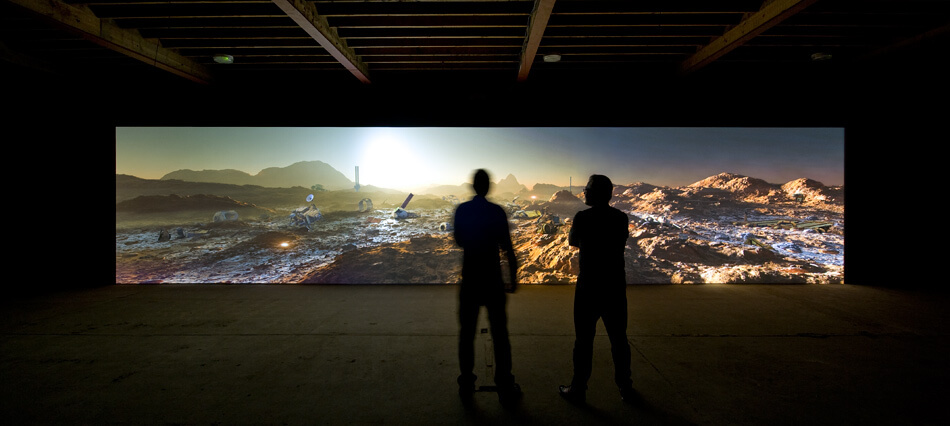Voyage and Violence: The 2017 Canadian Biennial at the AGA
It is an exciting year for the Canadian Biennial. For the first time in its history, the exhibition is spread across two venues, the National Gallery of Canada in Ottawa and the Art Gallery of Alberta in Edmonton. Turbulent Landings: The NGC 2017 Canadian Biennial at the AGA features recent contemporary acquisitions from the National Gallery that explore themes of violence, trauma, voyage, land, colonialism and nationhood.
“The NGC 2017 Canadian Biennial and its companion exhibition present a selection of powerful works that are leading discussions in the contemporary art world,” says Jonathan Shaughnessy, Associate Curator of Contemporary Art at the National Gallery of Canada, in an interview with NGC Magazine. From Beau Dick to Julie Mehretu, Chris Ofili and Kelly Richardson, “Turbulent Landings explores the different ways in which these artists address turbulent histories and geopolitical subjects creatively today.”
The show is oriented in the work of John Akomfrah and Mark Bradford, who, Shaughnessy says, were the catalysts for the premise of the exhibition. Akomfrah’s Vertigo Sea (2015) — a forty-three-minute, three-channel video — confronts difficult subject matter in a graphic way, including slavery, environmental destruction, whaling and the atomic bomb. “It’s an epic narrative about humanity’s propensity to exploit other human beings and the environment as well as harness natural resources towards destructive ends,” says Shaughnessy. “A troubling, complicated work that conflates sublime, beautiful footage with an abundance of sometimes graphic content, Vertigo Sea is central to the exhibition and resonates profoundly with the title of the show.”
Bradford’s Africa (2013) similarly explores slavery through the layering of paper obtained from the first trade-route atlas of the Dutch East India Company. “Bradford’s looking at centuries of movement and trauma through this piece, which is derived from the pages of the atlas that mapped routes of economy and the early slave trades,” says Shaughnessy.
As visitors travel through the exhibition, they encounter works by Shuvinai Ashoona and John Noestheden, Rebecca Belmore and Edward Poitras, who have been featured in previous biennials and remain relevant within the context of the Turbulent Landings narrative at the AGA. Poitras’ sculpture 2000 Pounds of Rope (2004), for example, references the rope used to hang Louis Riel — politician, Métis leader and founder of Manitoba who was executed for high treason for his role in the 1885 North-West Rebellion. Other works on view include Hajra Waheed’s The Cyphers (2016) — a multimedia installation of metal objects, drawings and collages referencing issues of violence, privacy, surveillance and personal autonomy — and Kelly Richardson’s Mariner 9 (2012). Here, a three-channel video installation portrays the colonization of Mars as a result of space exploration. “There are relics languishing on this planet that have already been discovered and disregarded,” says Shaughnessy. “It’s a portrayal of a dystopian future that ties into the exhibition’s theme of land and landings.”
Wael Shawky’s Cabaret Crusades (2010–2015) opens up a discussion about global atrocities and claims over sacred land. Presented as a video trilogy — with two parts on view at the Biennial exhibition at the National Gallery — Shawky’s work recounts the age-old battle for Jerusalem as described in Amin Malouf’s 1983 study The Crusades Through Arab Eyes. Using handmade marionettes, Shawky explores subjects of invasion, identity, assassination, injustice, greed and bloodshed from a historical perspective. “This elaborate project has received critical acclaim throughout the art world, speaking as it does to a subject that continues to resonate in present day global relations,” says Shaughnessy.
Taken in its entirety, Turbulent Landings does more than simply shine a light on contemporary creative talent — it encourages discourse on sometimes difficult subject matter, bringing the power of contemporary Canadian and Indigenous art into focus. From sculptures to paintings, installations, films, photographs, and drawings, Turbulent Landings “is an exhibition that presents some of the most engaging and riveting works of contemporary art that the National Gallery of Canada has acquired,” says Shaughnessy. “Works that have resonance for both Canadian artists and audiences alike.”
Published by National Gallery of Canada Magazine (original article)
Turbulent Landings: The NGC 2017 Canadian Biennial, curated by Jonathan Shaughnessy, Catherine Crowston and Josée Drouin-Brisebois, is on view at the Art Gallery of Alberta as part of the NGC@AGA exhibition series until January 7, 2018. The 2017 Canadian Biennial, also curated by Jonathan Shaughnessy, brings together a comprehensive selection of works acquired by the National Gallery of Canada since 2014. Featuring the work of more than fifty artists, the biennial is on display at the Gallery until March 18, 2018. If you would like to share this article, please click on the arrow at the top right of this page.
